Vickers VC.1 Viking Video - G-AGRU "Vagrant" - Cosford
|
|
Vickers VC.1 Viking
VC.1 Viking
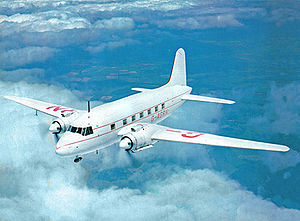
Picture - Vickers Viking 1A, G-AGRN
Role: airliner
Manufacturer: Vickers-Armstrongs Limited
Designed by: R.K. Pierson
First flight: 22 June 1945
Introduced: 1946
Primary user: British European Airways
Produced: 1945 - 1949
Number built: 163
Developed from: Vickers Wellington
Variants: Vickers Valetta
Vickers Varsity
The Vickers VC.1 Viking was a British twin-engine short-range airliner derived from the Vickers Wellington bomber and built by Vickers Armstrongs Limited at Brooklands near Weybridge in Surrey. In the aftermath of the Second World War, the Viking was an important airliner with British airlines pending the development of turboprop aircraft like the Viscount. An experimental airframe was fitted with Rolls-Royce Nene turbojets and first flown in 1948 as the world's first pure jet transport aircraft.
Design and development
The Ministry of Aircraft Production ordered three prototype Wellington Transport Aircraft to Air Ministry Specification 17/44 from Vickers-Armstrong Limited. The specification was for a peacetime requirement for a medium-short haul passenger aircraft. To speed development the aircraft used the wing and undercarriage design from the Wellington but the fuselage was new. Although the original contract referred to Wellington Transport Aircraft, on completion, the name Viking was chosen.
The prototype (designated the Type 491 and registered G-AGOK) first flew at Wisley Aerodrome on 22 June 1945. This aircraft crashed on 23 April 1946 due to a double engine failure; no fatalities occurred as a result of the crash. Following successful trials of the three prototypes the British Overseas Airways Corporation (BOAC) ordered 19 aircraft. The first BOAC aircraft flew on 23 March 1946. The prototypes were then used for trials with the Royal Air Force which lead to orders for military versions (the Viking C2 (12 ordered as freighter/transports) and modified Valetta C1).
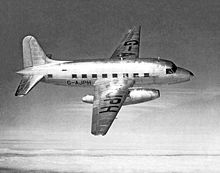
Picture - The jet-powered Vickers Nene Viking G-AJPH
The initial 19 production aircraft (later designated the Viking 1A) carried 21 passengers, they had metal fuselages and fabric-clad geodetic wings and tail units. Following feedback from customers, the next 14 examples, known as the Viking 1, featured stressed-metal wings and tail units. The next variant, the Viking 1B, was 28 in (71 cm) longer, carrying 24 passengers with up-rated Bristol Hercules piston engines, achieved a production run of 115. One of this batch was changed during production to be fitted with two Rolls-Royce Nene turbojet engines and upon its first flight on 6 April 1948 became the world's first entirely jet-powered airliner (albeit only a prototype). The Type 618 Nene-Viking flew Heathrow-Paris on the anniversary of Blériot's crossing of the Channel, 1948 taking only 34 minutes (c.210 mi/340 km, 370.6 mph/596.4 km/h). Some six years later, it was converted to a piston engined Viking.
Production finished in 1948, including 16 for the RAF and the King's Flight, but in 1952 BEA adapted some to a 38-passenger layout, taking the maximum payload up from 5,500-7,200 lb (2,500-3,300 kg). All Vikings featured a tailwheel undercarriage.
The 158th Viking became the prototype of the military Valetta, of which 261 were sold. When production of this strengthened but externally-similar type ended in 1951, a flying classroom version with tricycle undercarriage was already being delivered to the Royal Air Force (RAF), called the Varsity. All but one of those entered RAF service, the other example going to the Swedish Air Force. The production of 161 Varsitys kept the Hurn works busy until January 1954, and they enjoyed a long service life. Examples are preserved at Brooklands Museum, the Imperial War Museum Duxford and the Newark Air Museum.
Operational history
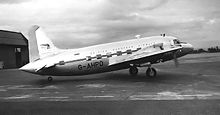
Picture - BEA Vickers Viking 1B G-AHPO "Venturer" at Manchester in 1952
The first Viking was flown from Vickers' flight test airfield at Wisley, Surrey, by chief test pilot Joseph "Mutt" Summers on 22 June 1945 and the third aircraft built was delivered to BOAC at Hurn near Bournemouth on 20 April 1946. Upon the delivery of nine examples to BOAC for development flying, including the two remaining prototypes, British European Airways (BEA) was established on 1 August 1946 to operate airliners within Europe and these first VC.1 Vikings were transferred to the new airline.
After a trial flight from Northolt to Oslo on 20 August 1946 by the newly formed BEA, the first regular Viking scheduled service commenced between Northolt and Copenhagen on 1 September 1946.
In all 163 Vikings were built. The initials "VC" stood for Vickers Civil, echoing the "DC" precedent set by the Douglas Aircraft Company of the USA, builders of the DC-1, DC-2 and DC-3 Douglas Dakota, the latter also bought by BEA and of a similar configuration to the Viking. Vickers soon ceased to use the 'VC' letters, instead using type numbers in the 49x and 600 series, which indicated the specific customer airline.
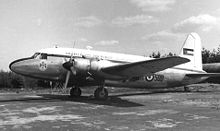
Picture - Viking 1B of the Arab Legion Air Force (Jordan) at Blackbushe Airport, Hants, in April 1955
BEA operated their large fleet of Vikings on many European and UK trunk routes for eight years. From 1951, the remaining fleet was modified with 36, instead of 27 seats, and named the "Admiral Class". BEA operated the Viking until late 1954, when the last was displaced by the more modern and pressurised Airspeed Ambassador and Vickers Viscount.
BEA sold their Vikings to several UK independent airlines for use on their growing scheduled and charter route networks. Some were sold to other European operators. An ex-BEA Viking 1B was fitted out as a VIP aircraft for the Arab Legion Air Force, mainly for the use of the King of Jordan. Most Vikings had been retired from service by the mid 1960s and the sole surviving example in the UK is owned by Brooklands Museum where it is under long term restoration.
Variants
Viking
Prototypes with two 1,675 hp (1,250 kW) Bristol Hercules 130 engines, three built.
Viking 1A
Initial production version with geodetic wings and two 1,690 hp (1,261 kW) Bristol Hercules 630 engines.
Viking 1
Production aircraft with stressed skin mainplanes and two 1,690 hp (1,261 kW) Bristol Hercules 634 engines.
Viking 1B
Viking 1 with "long nose", 113 built.
Nene Viking
One Viking 1B aircraft modified for trials with two 5,000 lbf (22.3 kN) Rolls-Royce Nene I turbojets.
Viking C2
British military designation of the Viking 1; VIP transport aircraft for the King's Flight of the RAF.
Valetta C2
Modified design with strengthened floor and large freight door.
Varsity T1
Modified Valletta design with tricycle undercarriage for navigation and crew training.
Type numbers
Type 491
First prototype
Type 495
Second protoype
Type 496
Third prototype
Type 498
Viking 1A for British European Airways
Type 604
Viking 1B for Indian National Airways with two Hecules 634 engines.
Type 607
Valetta prototype for Ministry of Supply with two Hercules 634 engines.
Type 610
Viking 1B for British European Airways
Type 613
Projected fuel transport variant, not built.
Type 614
Viking 1A for British European Airways
Type 615
Viking 1 for the Argentine government with two Hercules 634 engines.
Type 616
Viking 1 for Central African Airways
Type 618
Nene Viking for Ministry of Supply
Type 620
Viking 1 for the Argentine government with two Hercules 630 engines.
Type 621
Viking C2 for the Royal Air Force with two Hercules 130 engines.
Type 623
Viking C2 for the Royal Air Force with two Hercules 134 engines. Two ordered for use by the King's Flight for a royal tour of South Africa, one aircraft for the King and one for the Queen.
Type 624
Viking C2 for the Royal Air Force with two Hercules 134 engines. One ordered for use by the King's Flight for a royal tour of South Africa for use by the state officials in 21-seat configuration.
Type 626
Viking C2 for the Royal Air Force with two Hercules 134 engines. One ordered for use by the King's Flight for a royal tour of South Africa as a mobile workshop support aircraft.
Type 627
Viking 1B for Airwork Limited
Type 628
Viking 1B for DDL with two Hercules 634 engines.
Type 631
Projected 34-seat variant, not built.
Type 632
Viking 1B for Air India with two Hercules 634 engines.
Type 634
Viking 1B for Aer Lingus with two Hercules 634 engines.
Type 635
Viking 1B for South African Airways with two Hercules 634 engines.
Type 636
Viking 1B demonstrator.
Type 637
Valletta C1 for the Royal Air Force with two Hercules 230 engines.
Type 639
Viking 1 for British European Airways
Type 641
Viking 1 for Suidair International
Type 643
Viking 1 for Suidair International with two Hercules 630 engines.
Type 644
Viking 1B for Iraqi Airways
Type 649
Viking 1B for Pakistan Air Force with two Hercules 634 engines.
Type 651
Valetta C1 for the Royal Air Force with two Hercules 634 engines.
Type 657
Vicking 1A conversions from Type 498 for BSAAC.
Operators
Civil operators
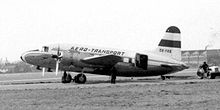
Picture - Vickers Viking 1 of Aero-Transport (Austria) in 1958
Argentina
Aerolxneas Argentinas
Argentine Civil Aeronautics Board
Flota Aérea Mercante Argentina
Austria
Aero Transport
Denmark
DDL
Egypt
Misrair
France
Airnautic
Air Dauphine
Air Inter
Air Sahara
Europe Aero Service
Transportes Aeriens Reunis
Germany
Aero Express Flug
Aerotour
Colombus Luftreederei
Condor Flugdienst
Deutsche Flugdienst
LTU International
Transavia Flug
India
Air India
Indian Airlines Corporation
Indian National Airways
Iraq
Iraqi Airways
Iraq Petroleum Transport Company
Ireland
Aer Lingus
Kuwait
Kuwait Oil Company
Mexico
Bernado Pasquelle
Government of Mexico
Portugal (Portuguese India)
Transportes Aéreos da xndia Portuguesa
South Africa
Protea Airways
South African Airways
Suldair International Airways
Trek Airways
United Airways
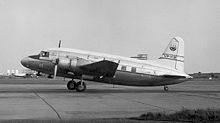
Picture - Central African Airways Vickers Viking at London Heathrow in May 1953
Southern Rhodesia
Central African Airways
Switzerland
Balair
Trinidad and Tobago
British West Indian Airways
United Kingdom
African Air Safaris
Air Ferry
Air Safaris
Airwork Services
Autair
Bembridge Air Hire Limited
BKS Air Transport
British European Airways
British Overseas Airways Corporation (used only by BOAC development flight)
Eagle Aviation/Eagle Airways
British International Airlines
British Nederland Airservices
Channel Airways
Continental Air Services
Crewsair Limited
Decca Navigator Company
Dragon Airways
Eros Airlines (UK)
Falcon Airways
Field Aircraft Services
First Air Trading Company
Hunting Air Transport
Hunting-Clan Air Transport
Invicta Airways / Invicta International Airways
Independent Air Travel
James Stuart Travel Limited
Maitland Drewery Aviation
Meredith Air Transport
Orion Airways
Overseas Aviation
Pegasus Airlines
Tradair Limited
Trans World Charter
Vendair Limited
Military operators
Argentina
Argentine Air Force
Australia
Royal Australian Air Force - One Viking C2 in service from 1947 to 1951.
No. 2 Squadron RAAF
No. 34 Squadron RAAF
Jordan
Arab Legion Air Force
Royal Jordanian Air Force
Pakistan
Pakistan Air Force
United Kingdom
Royal Air Force
Empire Test Pilots' School
The King's Flight, RAF
Accidents and incidents
Of the 163 aircraft built 56 aircraft were lost in accidents - the following were the notable accidents:
5 April 1948 - G-AIVP operated by British European Airways collided with a Soviet Yak-3 near Berlin, 15 killed.
21 April 1948 British European Airways Flight S200P crashed on approach to Glasgow-Renfrew Airport. No one was killed but 14 were injured.
8 February 1949 - OY-DLU operated by Det Danske Luftfartselskab (DDL) crashed into the sea off Oresund, Denmark, with the loss of all 27 occupants.
31 October 1950 - G-AHPN operated by British European Airways crashed on landing in bad visibility at London Heathrow Airport, England; 25 passengers and three crew died.
17 February 1952 - G-AHPI operated by Hunting Air Travel flew into the La Cinta mountain range, Italy, with the loss of all 31 occupants.
5 January 1953 - G-AJDL operated by British European Airways crashed on approach at Belfast-Nutts Corner Airport, Northern Ireland, three crew and 24 passengers died.
1 May 1957 - G-AJBO operated by Eagle Aviation crashed after engine failure near Blackbushe Airport, England, five crew and 29 passengers died.
2 September 1958 The 1958 London Vickers Viking accident happened when G-AIJE crashed into a house as the flight crew were trying to land back at London Heathrow Airport. All three crew died and four on the ground also died.
9 August 1961 - G-AHPM operated by Cunard Eagle Airways crashed into a mountainside near Holta on approach to Stavanger Airport, Sola in Norway with the loss of all 39 occupants.
11 September 1963 - F-BJER operated by Airnautic crashed into a mountain in the Pyrenees with the loss of all 40 occupants, the worst Viking accident.
Aircraft on display
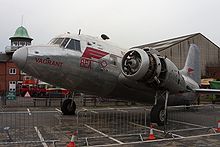
Picture - G-AGRU under restoration at the Brooklands Museum in 2009
Several Viking aircraft are on public display in aerospace museums worldwide, they include:
Viking 1A G-AGRU - On display/under restoration at the Brooklands Museum, Surrey, England
Viking 1A G-AGRW - On display near Vienna International Airport, Austria
Viking 1 G-AHPB - Was displayed in Technorama Museum at Winterthur, Switzerland. Scraped .
Viking 1 ZS-DKH - Partly restored , preserved in South Africa at OR Tambo International Airport.
Viking 1B T-9 - On display in Argentina
Viking 1B J-750 - On display at the Pakistan Air Force Museum Karachi, Pakistan.
Specifications (Viking 1B)
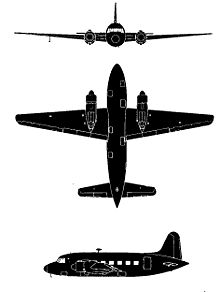
Picture - Vickers Viking 1B
Data from Vickers Aircraft since 1908
General characteristics
Crew: Two pilots
Capacity: 36 passengers
Length: 65 ft 2 in (19.86 m)
Wingspan: 89 ft 3 in (27.20 m)
Height: 19 ft 7 in (5.97 m)
Wing area: 882 ft² (82.0 m²)
Empty weight: 23,000 lb (10,430 kg)
Max takeoff weight: 34,000 lb (15,420 kg)
Powerplant: 2x Bristol Hercules 634 14-cylinder two-row radial engine, 1,690 hp (1,260 kW) each
Performance
Maximum speed: 263 mph (229 kn, 423 km/h)
Cruise speed: 210 mph (183 kn, 338 km/h)
Range: 1,700 mi (1,478 nmi, 2,740 km)
Service ceiling: 25,000 ft (7,600 m)
Rate of climb: 1,500 ft/min (7.6 m/s)
Wing loading: 38.5 lb/ft² (127 kg/m²)
Power/mass: 0.099 hp/lb (0.16 kW/kg)
Related development
Vickers Valetta
Vickers Varsity
Vickers Wellington
Bibliography
"Air Commerce: The Southall Accident: Report of the Public Inquiry". Flight, 21 August 1959, p. 58.
Andrews, C.F. and E.B. Morgan. Vickers Aircraft since 1908. London:Putnam, 1988. ISBN 0-85177-815-1.
Green, William and Gerald Pollinger. The Aircraft of the World. London: Macdonald, 1955.
Jackson, A.J. British Civil Aircraft 1919-1972: Volume III. London: Putnam, 1988. ISBN 0-85177-818-6.
Martin, Bernard. The Viking, Valetta and Varsity. Tonbridge, Kent, UK: Air-Britain (Historians) Ltd., 1975. ISBN 0-85130-038-3.
Taylor, H.A. "The Viking... Vickers Commercial One". Air Enthusiast, No. 21, April-July 1983, pp. 38-48. ISSN 0143-5450.
Vickers VC.1 Viking Pictures
Living Warbirds: The best warbirds DVD series.
Source: WikiPedia